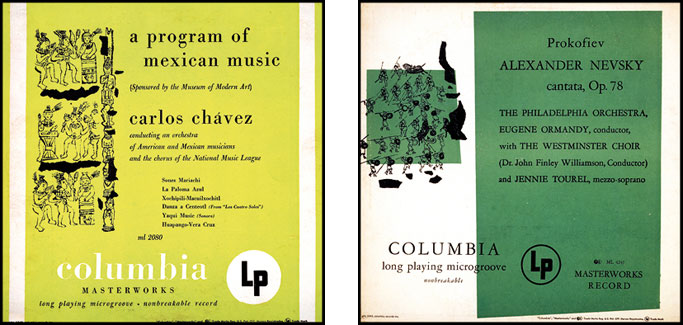Andy Warhol: From Nowhere to Up There
an oral history of Andy Warhol's early years
by Gary Comenas
page twelve
Paul Maréchal (Lecturer at the University of Québec in Montréal): Upon his arrival in New York, Warhol met with fellow schoolmates who had also moved to the Big Apple in the hope of making something of themselves. One of these friends was George Klauber, then working for a creative agency run by Will Burtin. Klauber introduced Warhol to Burtin, who was working with Robert M. Jones, art director of Columbia Records between 1945 and 1953, who then moved to RCA Victor. (PM6)
Robert M. Jones (Art director at Columbia Records, 1945-1953): I gave him three little spots to do for the corners of the standard albums. He needed money. I never kept any records but I know that these little spots must have been amongst the first things he did, certainly in the first three to six months he was here. I gave him three different ones to do, at $50 apiece. And two days later he came back with a stack of drawings like that to satisfy the three drawings we needed. (MS)

Two album covers featuring Warhol’s blotted line drawings – produced during his first year (1949) in New York Left: “a program of mexican music” conducted by Carlos Chavez (Two other versions of the cover – one with a blue background and another with a green background – also exist.)/ Right: Prokofiev’s Alexander Nevsky by The Philadelphia Orchestra conducted by Eugene Ormandy (reissued in the 1960s in two ‘known’ versions – one pink and the other orange). (PM)
Paul Maréchal: Commissioned by New York’s Museum of Modern Art (MoMA), this record [“a program of mexican music” above], released in 1949, was part of an important exhibition of Mexican art held at MoMA the same year… The pieces, which predate the Spanish conquest, are performed on modern instruments built according to specifications found in the Codex Florentinus, a document written by conquistadors in the sixteenth century… For the record cover, Warhol was directly inspired by one of the drawings in the Codex Florentinus, reproduced on page 13 of the program for the live concert organized by MoMA in May 1940… To illustrate this record cover, Warhol also used the blotted line technique… Some have credited the famous American artist Ben Shahn with the invention of this technique… The fact remains, however, that Warhol was familiar with this technique due to his Carnegie Tech professors, Wilfred Readio and Robert Lepper, who taught blotting to their students for the illustration of poems and short stories. (PM17)
Bennard B. Perlman: Although it has been theorized that Andy’s blotted line stemmed from the Bauhaus school and, in particular, the reproduction techniques advanced by Laszlo Moholy-Nagy, or that it derived from a suggestion made by instructor Robert Lepper, Lepper himself disputed both accounts. In fact, Andy discovered the blotted line accidentally, when he accompanied a group of classmates to the University Grill, an Oakland hangout, and made an ink sketch, then blotted it with a paper napkin. (BP158)
David Bourdon: According to Imilda Tuttle, who lived in New York during the early 1950s, Andy could be determinedly assertive, developing what she called an ‘aggressive shyness.’ She recalled a visit with him to a Doubleday bookstore on Fifth Avenue: ‘He just stood there and went through every record album, looking for record jackets he liked and jotting down the names of the companies that produced them. Then he went home, called up the companies, and said, ‘I’m Andy Warhol, I’d like to do a record jacket for you.’ His name meant nothing at that time. But out of the fifteen companies he called, he got maybe six appointments, and out of those, he got to do four or five jackets. He always did things that expressed himself. He did just what he wanted to do. (DB31)